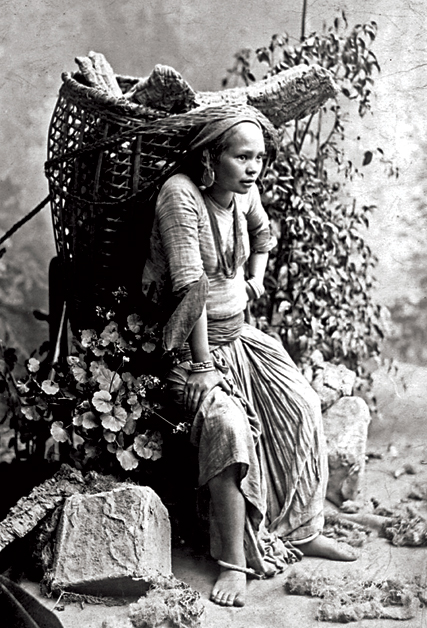‘How can this book be introduced?’, ask the authors in their introduction, sidestepping a number of definitions, since all of them fall short. After careful reading, I think I have an answer. Khangchend-zonga: Sacred Summit is the social history of an unusual mountain: rich, captivating and illustrated with an selection of modern and historical photos.
 The authors, both based in Sikkim, set out to scale in words what so many others have tried on foot: conquering the interwoven mythologies and oral literatures that swirl around the summit of the sacred Khangchendzonga.
The authors, both based in Sikkim, set out to scale in words what so many others have tried on foot: conquering the interwoven mythologies and oral literatures that swirl around the summit of the sacred Khangchendzonga.
Divided into 16 chapters, the book is stacked with detail and brimming with well chosen images. Wangchuk and Zulca’s journalistic backgrounds contribute to the data-rich and analysis-heavy reporting style, in which the past and the present are woven together seamlessly.
The first chapter deals with the relationship of the Lepcha community to Khangchendzonga. According to local beliefs, the mountain is the eldest brother of the Lepchas, in whose fresh snows the first Lepcha couple were created. Moving from myth to modern identity politics, the chapter concludes with a respectful discussion of the forces of change threatening the “clutch of Lepcha social organisations which are working hard to rediscover their roots and re-establish their connection with the land.”
Chapter two focuses on the Limbus of Sikkim, a group whose territorial identity is also deeply connected to the presence of Khangchendzonga. After a brief ethnohistory of the Limbus, the authors conclude that “Sikkim has sidestepped the concerns of one of its original people for far too long and the least respect it can show this resilient tribe is join in its celebration of a recognition long overdue.”
The third chapter addresses the claims of the Bhutia community to this sacred mountain. While the chapter order—Lepchas first, Limbus second, Bhutias third—is sure to raise a few eyebrows in the Sikkimese administration, the reviewer supports the authors in their decision. The autochthony of the Lepcha as the original inhabitants of what is modern day Sikkim, and the antiquity of Limbu settlements across the Nepal-Sikkim border are historical fact. The concept of a unified Sikkimese nation only emerged around 1646AD, when the kingdom was established under Phuntsog Namgyal (1604–1670), the first Chogyal, or ‘temporal and spiritual king.’ King Phuntsog belonged to the Bhutia community, a Buddhist people from eastern Tibet who entered Sikkim from the north and began settling there in the 13th century.
Chapters four, five and six are enjoyable reading. The section on mapping the mountain has elements of a detective novel and is matched by the exuberance of the early explorers.
The seventh chapter is a sobering reminder of the fact that those who attempt to scale Khangchendzonga risk their lives in the process. Entitled ‘Formidable Antagonist’, this chapter examines fatality rates among climbers, noting that Khangchendzonga ranks fourth highest, after Annapurna, Nanga Parbat and K2. While Khangchendzonga has been climbed by less than 200 mountaineers, 40 have already died on its slopes.
The next four chapters chart the trials and tribulations of various ascents on the mountain, including expeditions in the run-up to the 1955 success, the 1977 Indian army expedition and the British expedition of 1979. Final chapters deal with women and the mountain, art, contested spelling and yeti sightings.
Part of the challenge in writing something definitive about this mountain is that Khangchendzonga means so much to so many different peoples. In many ways, the peak is collectively owned and remembered by all who straddle eastern Nepal, Darjeeling and Sikkim, and each community has its own cultural and physical relationship with it. Full credit to the authors, then, for producing a book which is as enjoyable as it is educational. For readers interested in mountains and the peoples who live around them, Khangchendzonga: Sacred Summit is an unexpectedly rich narrative, thick with fact, pertinent analysis and glorious images. Highly recommended!
Published by Pema Wangchuk and printed at Hillside Press, Kathmandu, 2007. 372pp. (illus.). NRs 1,400. Available at most good bookshops.
A longer version of this review was printed in Read, 2008, Vol.2, No.1 (published quarterly by the FinePrint Book Club of Kathmandu, http://digitalhimalaya.com/collections/journals/read/). Dr Mark Turin is a linguistic anthropologist and Director of the Digital Himalaya Project (http://digitalhimalaya.com). Through the Namgyal Institute of Tibetology, he has been conducting a modern linguistic survey of Sikkim with a focus on languages in education.

You Don't Have to Destroy Everything Around You to Make Something Beautiful
Throughout the years, Cotton Mill Nepal has transformed crisis into opportunity. The 16 hours of load shedding in...










